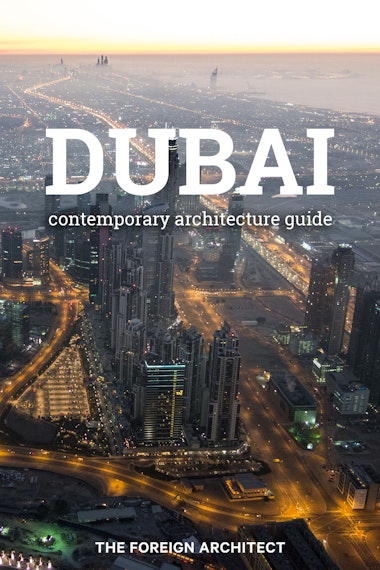Dubai: a curated contemporary architecture guide
Dubai’s architecture is extravagant, excessive, inconsequent and opulent. Despite all that, it is also mind-blowing, impressive, and unique. Go see it.
Dubai is largely admired by what is has achieved in the last 30 years. It became one of the richest cities in the world and generated some of the most daring and groundbreaking engineering and architectural achievements to date. It is home to the world’s tallest building, largest shopping mall, largest indoor ski slope. It is expanding its territory towards the sea in the shape of several human-made islands, as well as investing in innovative transportation technologies and infrastructure. It will host the World Expo 2020, reinforcing its position in the international scene as an economic powerhouse in the middle east.
But at what cost? A large city with the tallest skyline in the world, verdant green golf courses and lawns, swimming pools and an indoor ski slope is not something you should build in the desert, an environment where water is close to non-existent, the soil is sand, and frequent sandstorms and a sweltering heat threaten its existence. To keep its swimming pools, fountains and lush green lawns, Dubai residents consume 10% more water than an average American. All the water in Dubai comes from the sea through desalination process, with heavy environmental costs and energetic consequences. There is no water source more energy intensive than ocean desalination.
Add to it the destruction of its shore’s flora and fauna through the construction of its artificial islands, which in turn end up damaging its natural shoreline through modifications on tide currents. Not to mention problems caused by rapid population growth, such as sewage discarded in the sea due to insufficient waste treatment plants, which further threaten its natural environments. There is also the human aspect of this whole endeavor. Migrant workers enslaved by large constructions companies, forced to work in inhumane conditions comprise most of the workforce used to build the city. It is easy to find several reports about the state of human rights in the country, data naturally denied by the government and the more privileged population.
Therefore when you visit Dubai, be aware that what you are seeing might not be the whole picture. The fantastic touristic Dubai is to be taken with a pinch of salt. However, as an architect or an architecture enthusiast, Dubai is a must-visit city. Not only to learn through what's been done, the technical marvels this city has to offer. But also to question the viability of such grandeur.
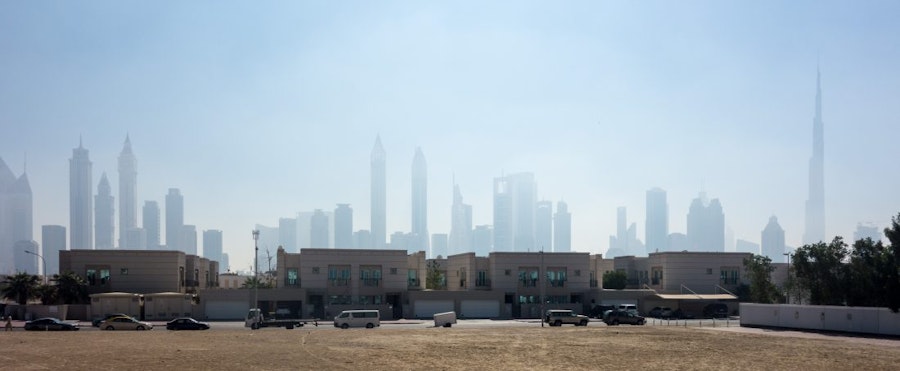
This Guide
My stay in Dubai was the result of an extended stopover. Therefore, I decided to have an overview of the city and visit only specific buildings. Since my visit, a few new buildings were completed which I believe are worth a visit. Additionally, some exciting projects are under construction which, together with the World Expo in 2020, will always make Dubai an appealing destination for many future stopovers or extended visits.
We’ll start by looking at Dubai’s number one attraction and its most impressive building: the mighty Burj Khalifa from SOM, still holding its position as the tallest in the world. Close by we’ll take a look at two buildings from Foster+Partners: the beautiful rotating screens of the recently opened Apple Dubai Mall, and the Index Tower, right off Sheikh Zayed Road.
Around the Business Bay, you’ll find a neat little building by Reiser+Umemoto, the O-14. Off to the shore, you’ll find the uncanny Burj Al Arab, by Atkins. Named by the media as the only 7-stars hotel in the world, it’s sail-shape and position just off the short on one of Dubai’s first artificial islands, made it probably one of the most recognizable buildings in the world. East to it you’ll find OMA’s first building in town, the art gallery Concrete at Alserkal Avenue.
Down south, you can visit the Palm Jumeirah, the only of the Palm islands already open and functioning. Also, marvel at the skyline of the Dubai Marina from the Palm, before heading there for more architecture porn. The Marina is impressive on its own, but I’ll focus on what is probably my second favorite building in Dubai: the Cayan Tower, also from SOM.
I’ll finish with a section on future projects to watch for, including the Opus Tower, by Zaha Hadid Architects, Fernando Donis's Dubai Frame, Calatrava’s Tower at Dubai Creek Harbour, and the Expo 2020 pavilions.
Map
There as just so many building in the city, and the map should help you identify any that may catch you eye! Black icons are mentioned in the articles, while gray ones are further recommendations (direct link):
Buildings
- Burj Khalifa - SOM
- The Index - Foster+Partners
- Apple Dubai Mall - Foster + Partners
- O-14 - Reiser + Umemoto
- Burj Al-Arab - Atkins Global
- Palm Jumeirah - Nakheel
- Cayan Tower - SOM
- Concrete at Alserkal Avenue - OMA
- The Opus Tower - Zaha Hadid Architects
- Dubai Frame - DONIS
- The Tower at Dubai Creek Harbour - Santiago Calatrava
- Expo 2020 Dubai
- Extras
Burj Khalifa - SOM
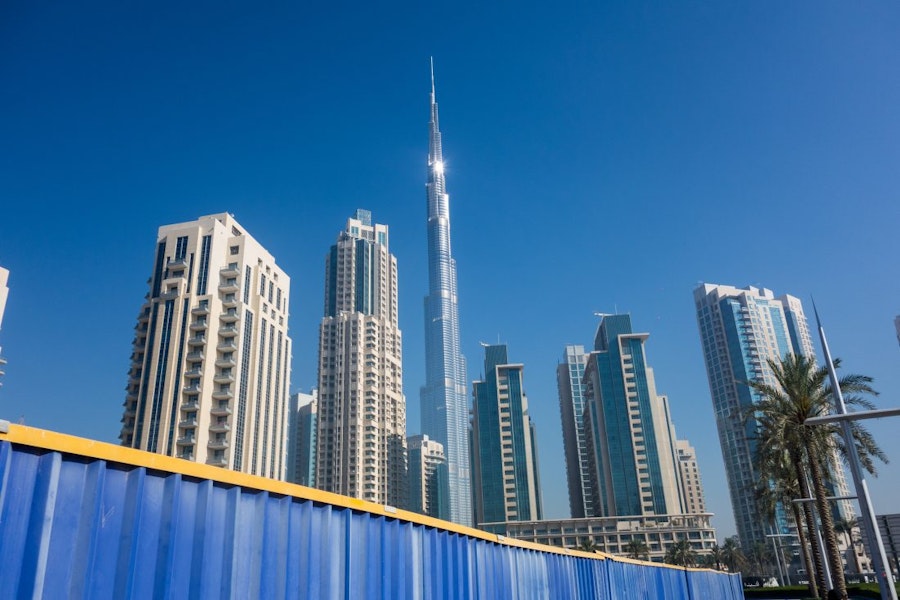
The tallest building in the world is also one of the main touristic attractions in Dubai. And for a good reason: the views from its observation deck are stunning and allow you to grasp the dimensions of this sprawling city. While standing at its feet, the tower does not feel so high. It is massive and seemingly unreachable, as most of its base is surrounded by the gigantic Dubai Mall (itself the world’s largest). It is most impressive, however, when looking at it from a distance, as a part of the city’s skyline. It towers so much higher than the other buildings, and offers a unique silhouette with its sharp tip, as a stalactite piercing through the earth towards the sky.
Visit
A while back, I wrote an article about visiting the Burj Khalifa. Check it out at Quick guide to visit the world’s tallest building: the Burj Khalifa in Dubai
The Index - Foster+Partners
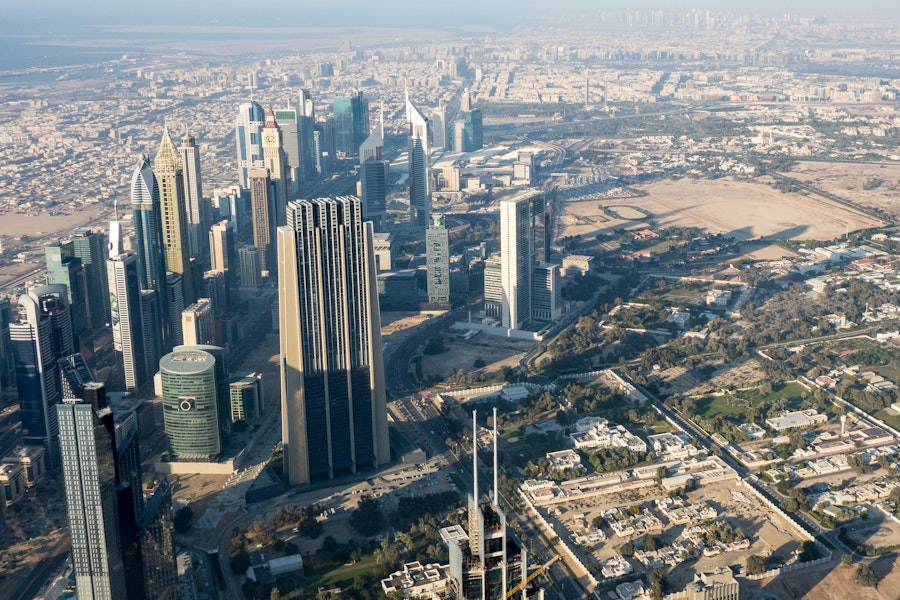
I first spotted it while at the top of the Burj Khalifa: a tower that stood out from its neighbors by rotating out of the grid and by looking very different from the rows of blue glass, arabesque-inspired towers lining Sheikh Zayed Road. It is an exquisite tower, three blocks sandwiched between four massive structural frames tapering towards the top.
Its orientation, different than all its neighbors, should be the norm and not an exception. It rotates from the city grid to have its shortest structural faces towards east and west, while its program faces north and south. The south face is then further protected from the sun via a system of horizontal louvers.
The programmatic division is clearly defined on its facade. The first 25 floors from the base are large office floors, while the top floors are residential apartments. Further sections are visible as a tall sky lobby right above the office for the tower residents, and the top floors containing penthouses. The base also houses commercial activities in a pleasant landscaped setting. It is a smart, well-designed, local-specific tower. Unfortunately, one of the few in the city that take climatic considerations so seriously.
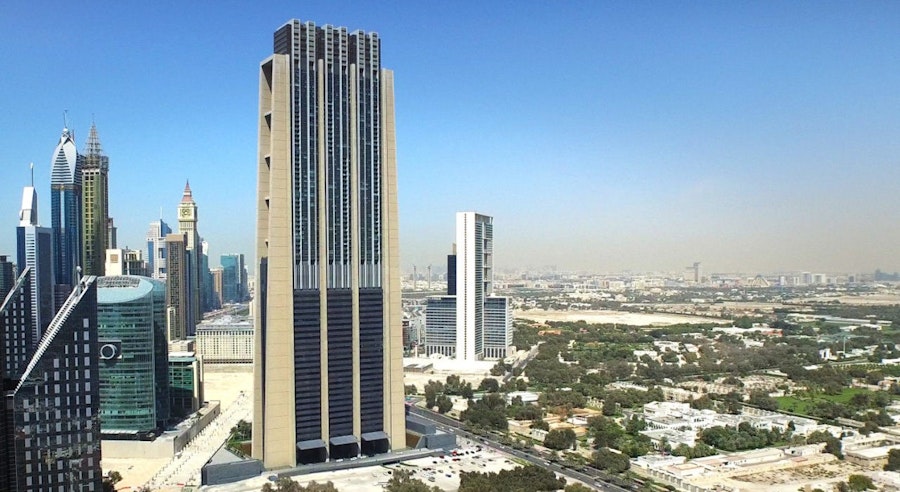
Visit
The base contains commercial activities and offices so you can circulate around. The residential areas, however, are off limits.
Apple Dubai Mall - Foster + Partners
Apple Stores have long been a symbol of what the brand stands for. All glass structure, staircases, facades and clean, simple interior spaces make the products come to the foreground. Its iconic design, debuted in the original Apple Store on Fifth Avenue in New York, has been successfully replicated throughout the world.
The Apple Dubai Mall, by Foster + Partners, however, stands out. It is not just another beautiful glass box, but it tries to be more accurate to its location. Its main design feature is the huge shading elements places along a curved facade overlooking the Dubai Fountains. These carbon-fiber panels, reminiscent of shading elements in middle-eastern architecture, help protect the store from the desert sun during the day and automatically open up at night in an elegant rotating gesture. This gives access to a wide balcony lined by trees (which themselves also rotate to allow for uniform sunlight “baking” of each tree), from where you can have one of the best views of the famous dancing fountains.
It is great to see how Apple kept its branding to a minimal on this facade. The Apple logo appears small on one of the balcony corners. It could be mistaken by a well-designed corner of the amorphous Dubai Mall in which it seats. It might be, besides the Burj Khalifa, the second only reason to visit this shopping mall.
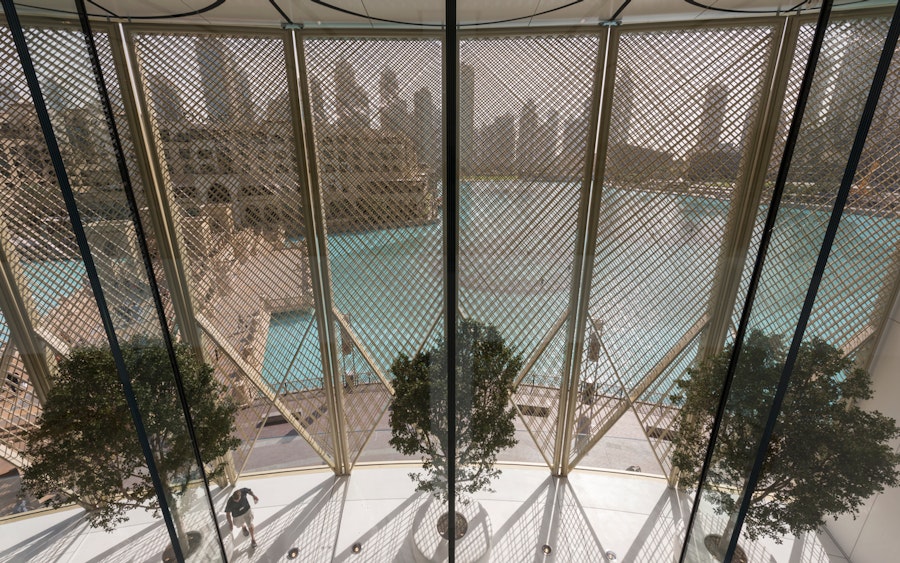
Visit
Got check it out and marvel at the details: the hand-carved stone staircases, the pattern on the shading panels, the outdoor balcony. It will be one of the most disputed viewing areas for the Dubai Fountain shows at night, but you might be able to squeeze in to get a place in between shows (it runs for about 5 minutes every half an hour starting at 18:00).
O-14 - Reiser + Umemoto
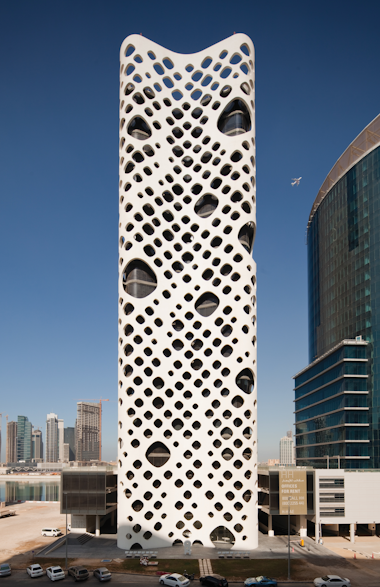
I remember being in school while trying to learn the exciting new possibilities of scripting in architecture, and seeing this building for the first time. It was, at the time, the epitome of complex computer-aided-design applied to architecture, and it inspired us all. Today, seven years later, it still stands as one of the most unique buildings in all of Dubai. Its exoskeleton structure allows for a smaller core and column-free office space while providing thermal protection against the desert sun. The openings on the facade follow a system in which more material is placed where the structural loads are greater, which makes the playful facade make a lot of sense. It stands on the edge of the Business Bay lake, small in height but great in presence.
Visit
It is an office building, so you should be able to circulate freely around the ground floor and even get an elevator ride to the top.
Burj Al-Arab - Atkins Global
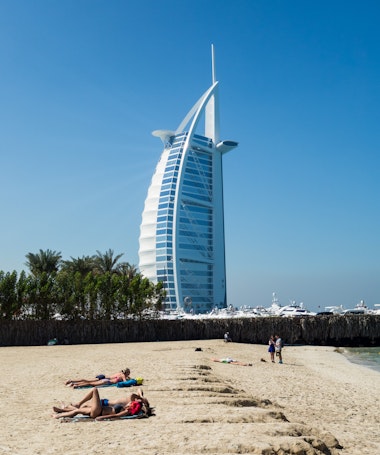
One of the most opulent symbols of Dubai, this 5-star hotel was built long ago in 1999. By then, Dubai was just starting to gain traction as a mecca for architectural novelties. The Burj Al Arab, designed by lead architect Tom Wright, was supposed to be the new symbol of the city, as the Eiffel Tower is for Paris or the Big Ben for London. The design resembles a sail, and the building is placed on its own little island just off the shore. It is a striking building, with large structural members supporting its triangular shape and different surface treatments on its facade. However, its contemporary design contrasts with a tacky interior with lots of gold and arabesque decorations. It may as well be a symbol for the city, but it is also a symbol of extreme opulence and extravagance.
Visit
The general public can catch glimpses of it from the nearby Jumeirah public beach, as the whole area including its beach is fenced off and you can only get in as a guest or with a reservation in one of the restaurants inside. The most common and cheapest way to visit it seems to be for afternoon tea at the Skyview restaurant, priced around 400AED, for which you can make a reservation online.
Palm Jumeirah - Nakheel
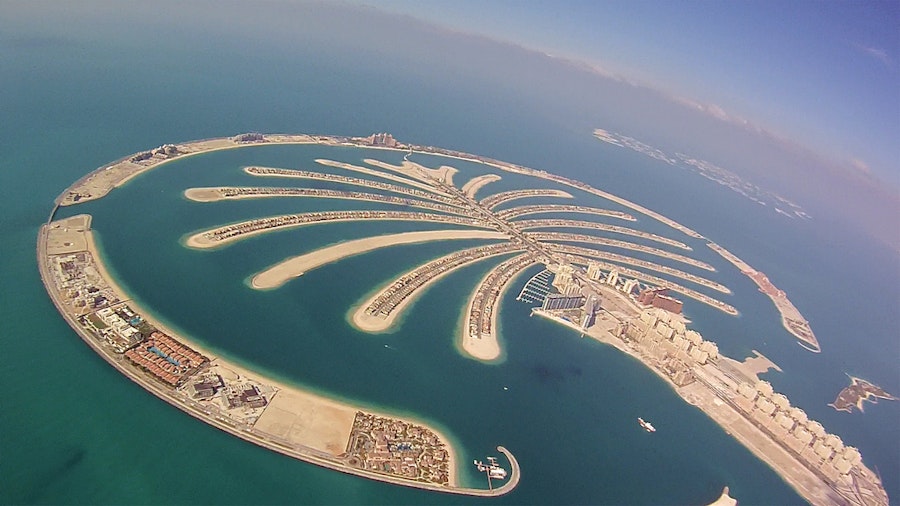
The Palm Islands is a project by developer Nakheel to extend Dubai’s shoreline by over 500km as three artificial “islands” in the shape of palm trees. The smallest and first of them is the Palm Jumeirah, completed in 2006 and currently housing several residences, hotels, and commercial centers.
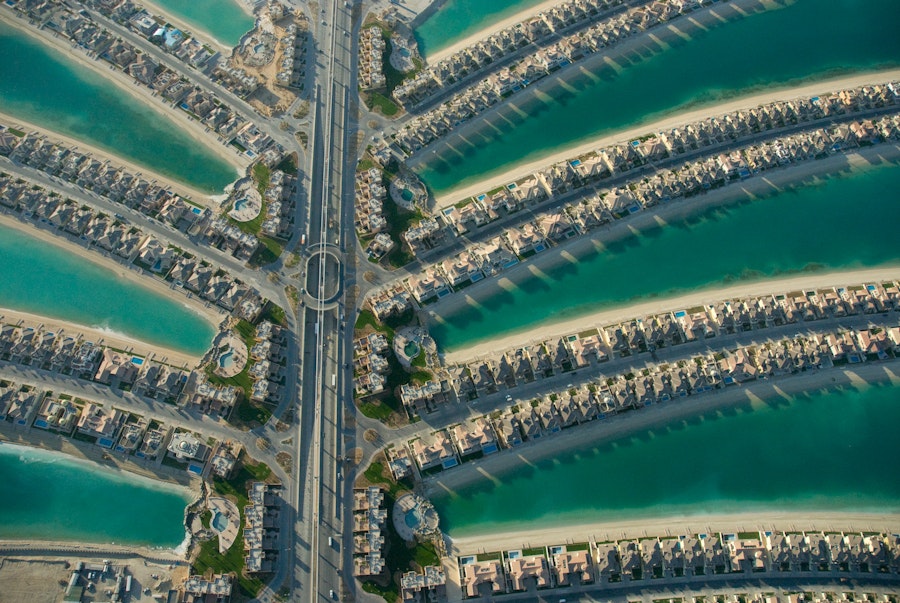
Being on the Palm feels like being in a beachside town, one that is under heavy construction and that is not very inhabited. On the palm “fronds” stretching out from the main “stem”, large houses occupy the “beachfront" bathed in bright blue waters. The palm’s 5km-long "stem" is like the beachside city’s main street, with taller residential buildings, a monorail line and stations and commercial establishments, including a large shopping mall under construction.
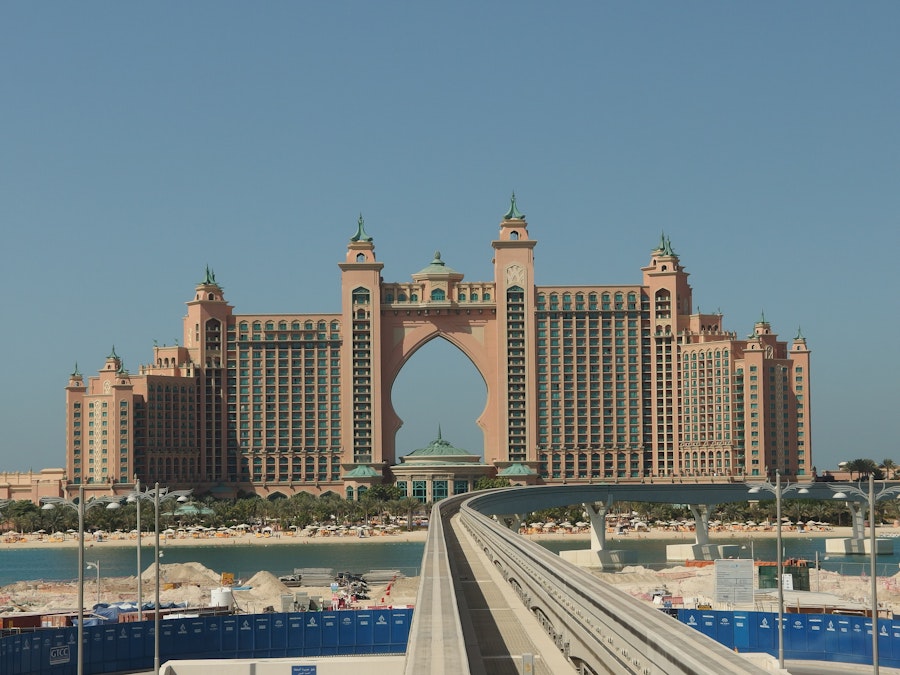
When you reach the top of the Palm, so called “the Crescent," you’ll find the opulent Atlantis Hotel: an underwater-themed luxury resort, shopping malls, and several upscale restaurants, including outposts of famous international restaurants such as Nobu or Gordon Ramsay’s Bread Street. If the Atlantis is too much for you, 27 other hotel options (!) spread along the crescent for you to choose from. Although it is all pretty solid as a real island, I couldn’t help but feel the fakeness of it. How artificial those beaches were, or how lifeless the sea looked. The rocks had no seaweeds, or moss, or all the natural stuff that appear on regular shorelines. As much as I looked for it, I could not see one single fish in the waters. Many of the houses were empty and some even turning derelict. And despite all this, the construction continued on. My WTF-moments were then intensified when I learned that the Palm’s much larger sibling was also on full construction some kilometers down the shore. So much for lessons (not) learned.


Visit
Take the monorail at the bottom of the Palm's "stem" and ride it all the way to the Atlantis Hotel. Stop along the way to check the “fronds” and try not to gasp at the exaggeration of it all.
Cayan Tower - SOM
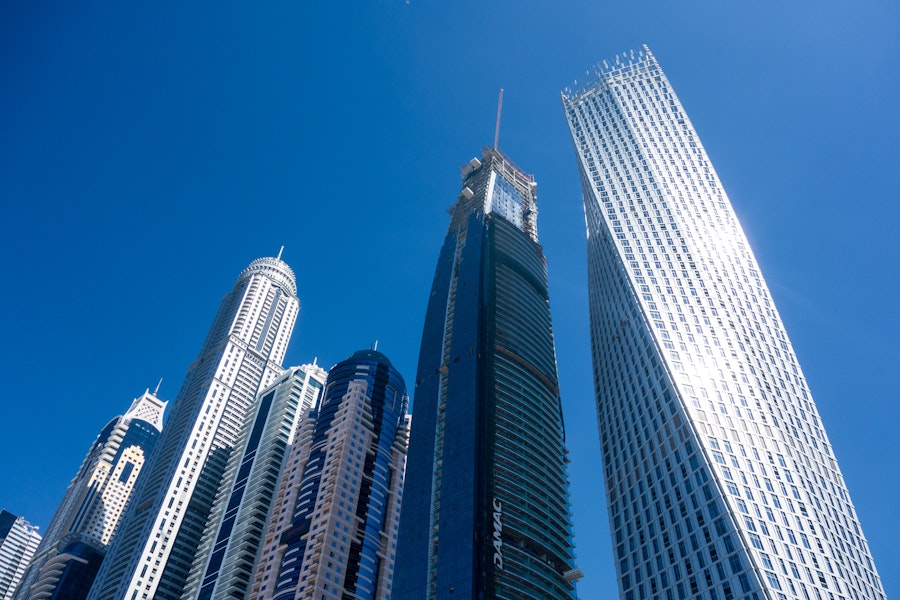
The Dubai Marina is a mindblowing area of Dubai. From afar, it is like a bundle of skyscrapers, thin and super tall. From within, it is a whole world of beachfront, marina, boardwalks, skyscrapers, and lots of yachts. Opulence as expected from Dubai. However, most towers in the area are eye-sores, either tacky, arabesque-inspired buildings, or non-descript glass and stone blocks.




The Cayan Tower, however, is unique. It is a simple move, immortalized by Calatrava in its Turning Torso building in Sweden, and taken to taller extremes in the latest Shanghai Tower: floor plan rotation along its height. The Cayman features square-shaped floor slabs rotated a full 90-degrees from base to tip. SOM uses both the views (bottom-half views to the marina, top-half views to the Gulf) and the wind (the twisted block “confuses” the wind) to justify the rotation.
The resulting metal-clad tower is beautiful and striking, the sun hitting its faces in different subtle ways. Coming closer, a fine pattern of metal panels and opening reveals itself, and the impossible twist is even more impressive. When it comes to designing super-tall towers, there is only so much you can do. Structural and technical issues are extremely restrictive, and anything that deviates from a simple extrusion and tapering becomes incredibly complicated. Every architect who designs such buildings dream of having the right client who is willing to invest in groundbreaking ideas, who is ready to risk and try to do something different. Be it just for show, or via unjustifiable expenses, it is still admirable.
As an architect that believes in the future of high-rises as problem solvers for our future cities, I believe that even unwarranted efforts such as the Cayman Tower’s 90-degree twist, or the Burj Khalifa’s impossible height are justifiable as means to push the field forward.
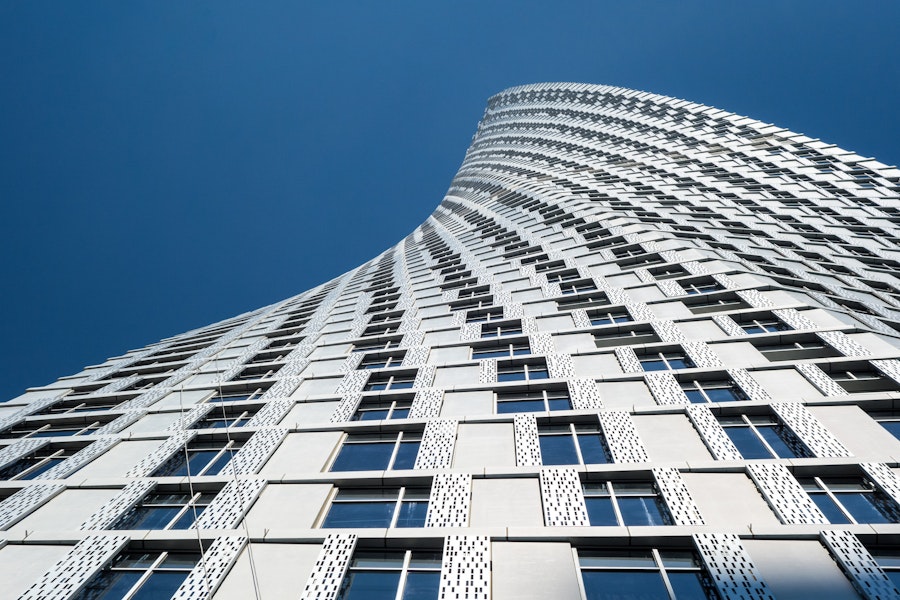
Visit
You can just walk around as the whole tower is a residential building and closed to visitors.
Cayan Tower
- 2013
- Residential
- 111,000sqm / 306m
Concrete at Alserkal Avenue - OMA
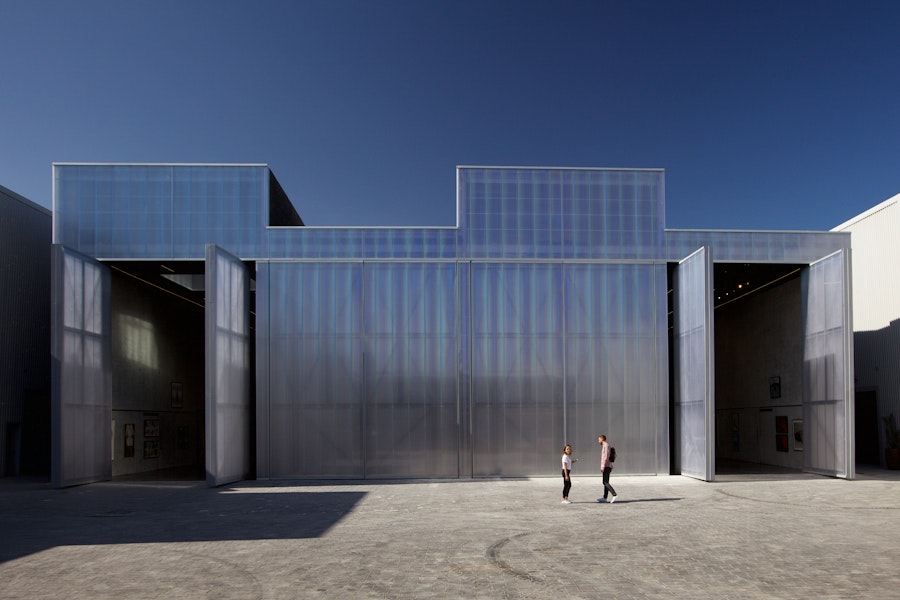
OMA’s first project in Dubai, this exhibition/event space is located at the Alserkal Avenue, an area founded in 2007 with the aim of promoting cultural initiatives in the city. It is a large building, characterized on one side by large polycarbonate doors that allow the building to completely open up to the area’s main square, while the back service area is covered with sprayed dark concrete.
Visit
It was inaugurated after my time in Dubai, so I did not have the chance to visit it. You can check the official website to check if any event or exhibition is happening.
The Opus Tower - Zaha Hadid Architects
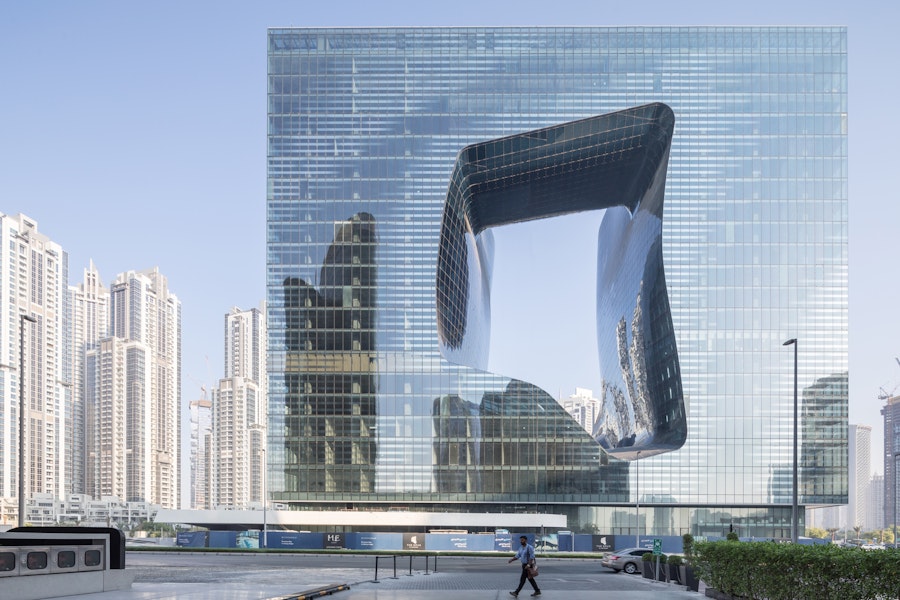
This is one of Zaha’s early high-rise projects that proved very complicated to design past the competition stage and built. Now, more than ten years later, you can already recognize its shape on the recently topped-off structure on the site it's done.. It is a fascinating building which is a unique addition to the city. The developers also recently announced that the building will house a permanent memorial to the late architect.
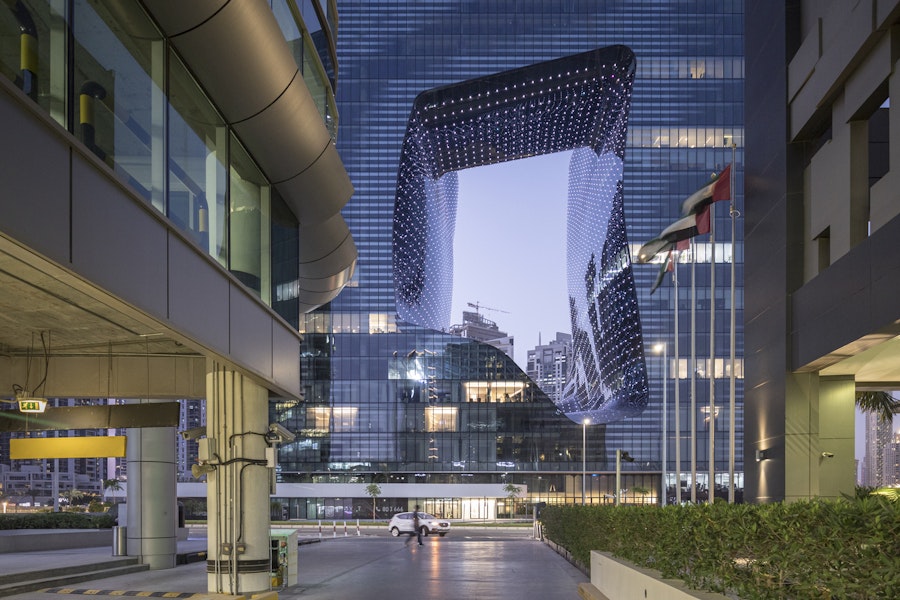
The buildings below are a selection of upcoming additions to the Dubai skyline that I am looking forward to visiting in my future trips.
Dubai Frame - DONIS
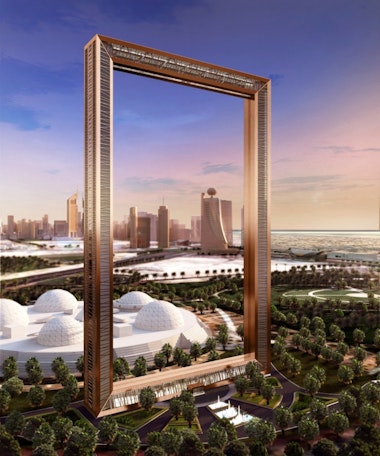
Another impossible building, the Dubai Frame is nearly complete eight years after its competition which selected the Mexican architect Fernando Donis as a winner. Donis, however, is suing the Dubai municipality for breach of copyright and theft of his design for the structure, claiming he was left out of the project’s execution and construction, never being compensated for his intellectual property.
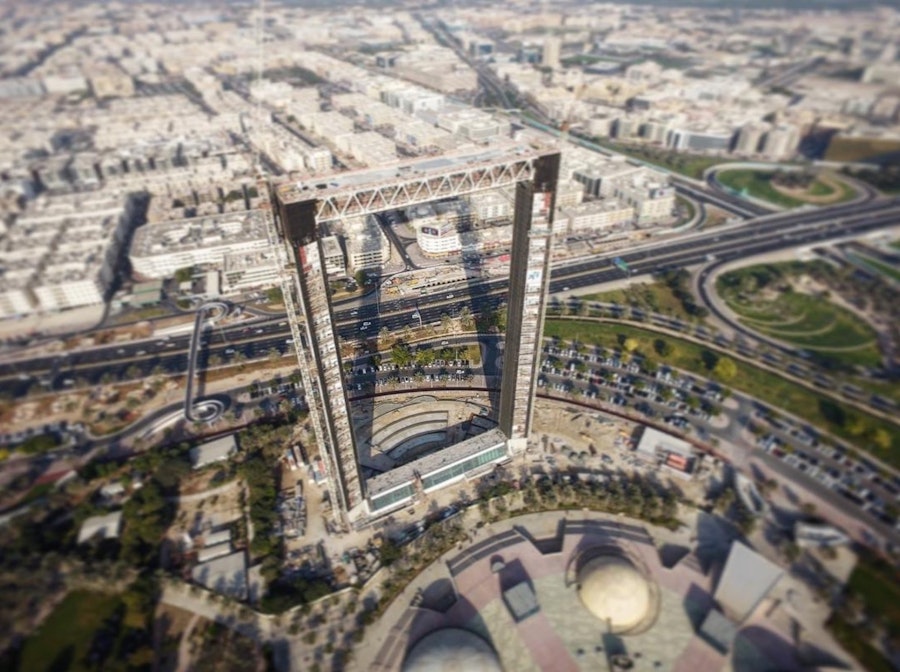
The project is scheduled to inaugurate late 2017 and will offer another high observation deck from which visitor will be able to marvel at Dubai from above.
The Tower at Dubai Creek Harbour - Santiago Calatrava
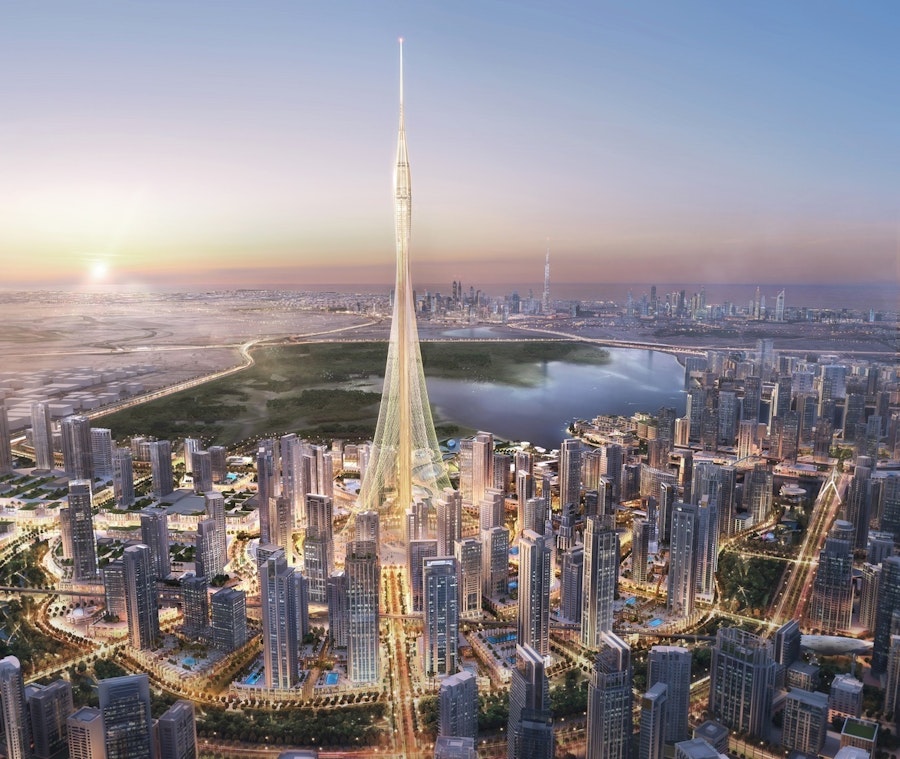
Calatrava’s Tower at Dubai Creek Harbour will be the world’s tallest structure when completed in 2020. Although 100 meters taller than its neighbor Burj Khalifa, its slender profile and unusual structure make it a whole different beast. It will function mainly as a public space with event areas, observation decks, and other facilities. It carries none of the heft from the Burj Khalifa, which also allows it to reach completion in around 3-years. It broke ground in the end of 2016, and its construction will surely be newsworthy in the next years. I am very much looking forward to it.
The Tower at Dubai Creek Harbour
- 2020
- Observation
- 928m
Expo 2020 Dubai
After the winning a bid against Brazil, Turkey, and Russia back in 2013, Dubai will host the 2020 World Expo. It selected as a theme "Connecting Minds, Creating the Future," sub-themes being Sustainability, Mobility, and Opportunity. It promises to be a boost to the city's economy, as it will attract attention and investments to Dubai's most important economic sectors, such as tourism and infrastructure.
World expos are also a playground for architecture. Several iconic designs were displayed in past expos, and some remain, until today, as remarkable examples of breakthrough design ideas and techniques. The Eiffel Tower (1889), the Seattle Space Needle (1962), BIG's Danish Pavilion and Heatherwick's British Pavilion (2010), are just some of the most memorable and enduring examples. Dubai's 2020 Expo will certainly score high on the list of great world expos. A few designs were already unveiled to inhabit HOK's master plan, including Foster + Partners Mobility Pavilion, BIG's Opportunity Pavilion, and Grimshaw's Sustainability Pavilion.



Extras
As I had little time in the city, I decided to try for the first time the Big Bus Tours, those double-decker buses on a hop-on/hop-off system. It proved to be one of my best decisions: it ran through all the spots I wanted to see (and many more), frequently enough so that I never had to wait more than 10 minutes for each bus. The weather happened to be quite pleasant in February, so sitting on the open deck was great, and allowed me to take a lot of the city in. I would love to have tried cycling or walking, but after reading how difficult both activities were in Dubai, the Big Bus was my best option. Recommended.
Dubai Flow Motion
The video above was created by Rob Whitworth after three months in Dubai and shows a unique view of how crazy this city is. The Dark Side of Dubai For a bit of reflection, take a look at this article by Johann Hari for the Indepent, exposing all the weight that comes with Dubai fast and inconsequent development. back to topPin it!
